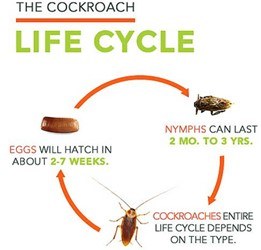German Cockroach Reproduction
Lifecycle of a German Cockroach
To beat these little invaders, you gotta know the enemy, starting with their lifecycle (check out German Cockroach Life Cycle). Folks, meet the German cockroach, officially tagged as Blattella germanica. These sneaky critters go through three life stages: egg, nymph, and adult.
| Lifecycle Stage | Duration | Key Characteristics |
|---|---|---|
| Egg | 3-4 weeks | Tucked inside an ootheca; mama cockroach hangs onto it like her personal purse till it’s hatching time |
| Nymph | 6-12 weeks | Needs to change outfits (molts) 5-7 times before graduating to adulthood |
| Adult | 100-200 days | Ready to start their own cockroach families; they’re around for about 6 months |
Picture this: Mama cockroach becomes an egg-toting adult in about 11-12 days. Each of her egg purses, or oothecae, can carry up to 40 future roaches (thanks, IFAS University of Florida). Throughout her raiding career, she could spit out between 5 and 8 of these baby bags (Done Right Pest Solutions). No wonder these dudes multiply like it’s going out of style!
Egg Development and Hatching
Let’s get into the nitty-gritty of roach eggs and see why their numbers are like bunnies in spring. The lady roach keeps the ootheca under her protection for about three weeks to make sure the little ones don’t get gobbled up (IFAS University of Florida).
Ootheca Insights:
- Think of them as little roach pods: about 3 mm wide, 8 mm long
- They’re split open with each section hiding a pair of egg twins
- A blue-green stripes appears when the roaches are about to make their debut
When it’s showtime, mama places her ootheca safely, and tada! In just a day or two, the new crew bursts out, kicking off their nymph stage. Over the next 6-12 weeks, they slip out of those tight skins 5-7 times (#WardrobeUpgrade) before adulting.
One determined female can spawn up to 300 little roaches before she’s done. So if you find signs of these critters, it’s smart to act fast and maybe even call in the pros to rain on their parade.
Factors Influencing Reproduction
Understanding what makes German cockroaches multiply like rabbits is key for managing them. Their baby-making habits are affected by a mix of environmental stuff and what’s on their menu.
Environmental Factors
German cockroaches are picky about their living conditions – watch how their multiplying speed is affected by temperature, humidity, and light.
Temperature: These creepy crawlies love it between 70°F (21°C) and 85°F (29°C). This cozy range means they grow up fast, reaching adulting milestones in just 100 days (Done Right Pest Solutions).
Humidity: The higher, the better for young roaches. Low humidity? That’s a desert for their kiddie brigade.
Light Conditions: Darkness is a roach’s best friend. Shine too much light, and you mess with their party time.
| Environmental Factor | Optimal Condition for Reproduction |
|---|---|
| Temperature | 70°F – 85°F (21°C – 29°C) |
| Humidity | High |
| Light Conditions | Dark |
Curious about their life blueprint? Check our German cockroach life cycle page for more deets.
Nutritional Considerations
What a cockroach chomps down on matters a lot for its family expansion plans. The menu and buffet size impact their life plus baby count.
Quality of Food: They’ll munch on anything, but are real suckers for starchy snacks, meats, and sweets. Better grub means they grow and reproduce faster.
Food Availability: If the munchies are always on, female roaches can pop out 4 to 6 egg cases (also known as oothecae), and each holds 30 to 40 mini-roaches.
Hydration: Water is life! Dry spells can really hold up their breeding game.
Want to know what’s on their menu? Slide over to our what do German cockroaches eat page.
Realizing how these factors play out allows anyone battling a German cockroach infestation to disrupt their breeding plans. Controlling their hangout and menu can reduce their numbers and bring some peace back. For strategies on eviction, look into our how to get rid of German cockroaches tips.
Get the hang of these cockroach love secrets, and you’ll make pest control way more than just a shot in the dark.
Behavior and Habitats
Grasping how German cockroaches act and where they lurk is key to kicking them out of your space for good.
Nesting Preferences
These pesky little critters are choosy about where to hang their hats, and it really makes a difference in how many of them stick around. They dig warm and wet spots where they can slip into survival mode near every food stash they can find. Peek in your kitchen, bathrooms, or anywhere moisture’s high—odds are, that’s where they’re setting up camp.
Female German roaches do this peculiar thing where they tote their egg capsules for a bit—anywhere from a half day to nearly a week—before dropping them off somewhere cozy and snack-adjacent. Once hatched, the young ‘uns, or nymphs, grow up in these hideaways, making it pretty comfy for them to wreak havoc for several months to a year until they’re all grown. As for the adult gals, they don’t hang around too long—just a quick 1 to 6 months.
Shelter Selection Trials
When picking shelters, these cockroaches have pretty clear preferences that play nice with their survival instincts. Playing house, they pick up on what feels comfy through touch, which keeps them chill and thriving.
One study went deep into this, tracking how these roaches made a beeline for hideouts with angles ≤40° within both 15 minutes and 24 hours (PMC). Shelters with sharper corners, like 90° or even 180°, seemed to give them the frights, messing with their mojo and making them less baby-prone.
| Shelter Angle | Do They Dig It? | Stress Levels |
|---|---|---|
| ≤40° | Totally | Chill vibes, no stress |
| 90° | Nope | Major stress, dragging out youth phase, less breeding |
| 180° | No way | Stress city, stunted growth, dire survival stats |
The study nailed down that both grown-ups and kiddies among German cockroaches gravitated toward more relaxed angles up to 40°. The young ones especially found safety in shelters with angles like 10°, 20°, 30°, and 60°, proving anything over 40° messes with their stride and survival.
This adaptability underscores just how sneaky they can be, showing us the silver bullet is to make sure their digs aren’t up to snuff so they’ll skedaddle. For more nitty-gritty on dealing with these unwelcome guests, take a look at our bits on german cockroach nest and how to get rid of german cockroaches.
Tuning into these behavioral quirks is the power move for rolling out slick pest control plans to boot German cockroaches out of your home or business. For a deeper dive into their lifecycle and knack for multiplying, swing by german cockroach reproduction.
Management and Control
Getting a handle on the baby-making machine that is the German cockroach means blending some DIY know-how with bringing in the pros when needed. Here, we’ll peek into the world of prevention and professional help, helping homeowners keep these sneaky pests in check.
Preventative Measures
Stopping these critters from setting up shop in your place costs way less than kicking them out once they’re all nice and comfy. Here’s how you fend ’em off:
1. Keep It Tidy:
German cockroaches love a pigsty. Regular tidying up dissuades them from dropping by your humble abode.
2. Lock Down Food and Water:
Don’t leave scraps for a midnight snack. Clean dishes lickety-split and stash food in containers with a tight lid. Mop up spills and handle any leaky faucets fast.
3. Seal All the Little Ways In:
Roaches sneak through tiny cracks. Use stuff like caulk to close off these roach expressways.
4. Regular Check-ins:
Scout out their favorite hangouts, like the kitchen, bath, and basement. Spotting egg cases or little poop bits? That means you’ve got company. Want more on spotting the invaders? Head to german cockroach infestation.
| Preventative Measure | Description |
|---|---|
| Cleanliness | Keep living areas clutter-free. |
| Food/Water Elimination | Store food in sealed containers and repair water leaks. |
| Sealing Entry Points | Block cracks with caulk or similar. |
| Inspections | Regularly check for infestation signs. |
Discover more about cockroach dislikes at what do german cockroach hate.
Professional Eradication Options
If the bugs are throwing a fiesta in your home, you might need the bug-busting experts. They’ve got tools and tricks that aren’t on the store shelves.
1. Chem Warfare:
Pros sling some serious insecticides that knock these bugs out cold. Just make sure to clear the house when they do their thing.
2. Mix and Match Pest Control (IPM):
This all-encompassing strategy brings together sprays, traps, and other tweaks to make your home less roach-friendly. It’s a long game but a smart one.
3. Bring the Heat:
Some companies take the heat up a notch, reaching temps that spell doom for roaches. No chemicals here—just scorch and scuttle.
4. Pros on the Lookout:
Having the experts in regularly nabs those sneaky return visits. Sometimes, a follow-up round can crush the remaining hangers-on.
| Eradication Option | Description |
|---|---|
| Chemical Treatments | Strong insecticides applied by pros. |
| Integrated Pest Management (IPM) | Combining sprays, traps, and habitat changes. |
| Heat Treatments | Elevating temperatures to wipe out cockroaches. |
| Professional Inspections | Ongoing inspections and additional treatments. |
For a breakdown on costs and pro tactics, head over to german cockroach extermination cost. Want in-depth on expert methods? Check out how to get rid of german cockroaches.
By blending smart home habits with the occasional help from the experts, German cockroach control isn’t just a dream. Mastery of these pest-fighting tactics spells the end for the tiny invaders raiding your kitchen.

